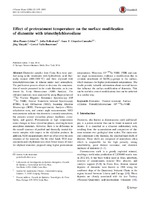Effect of pretreatment temperature on the surface modification of diatomite with trimethylchlorosilane

Date
2016Author
Puente-Urbina, Allen
Hollenbach, Julia
Céspedes-Camacho, Isaac
Matysik, Jorg
Valle-Bourrouet, Grettel
Metadata
Show full item recordAbstract
Diatomite samples from Costa Rica were purified
using acidic treatments with hydrochloric acid, thermally
treated (400–1000 C) and then silylated with
trimethylchlorosilane in toluene under inert atmosphere.
The purification process allows to decrease the concentration
of metals presented in the crude diatomite, as is confirmed
by X-ray Fluorescence (XRF) Analysis. The
silylated materials were analyzed by using Hyperpolarized
129Xe Nuclear Magnetic Resonance Spectroscopy (HP
129Xe NMR), Fourier Transform Infrared Spectroscopy
(FTIR), X-ray Diffraction (XRD), Scanning Electron
Microscopy (SEM), Thermogravimetric Analysis (TGA),
rehydration tests, and contact angle measurements. XRD
measurements indicate that diatomite is mainly amorphous,
but presents several crystalline phases (kaolinite, cristobalite,
and quartz). Pretreatments at high temperatures
cause changes in those crystalline phases, resulting in more
amorphous materials. However, there is no difference in
the overall structure of purified and thermally treated diatomite
samples with respect to the silylation products. In
addition, SEM measurements show no effect over the pore
structure of the materials. On the other hand, TGA measurements
and rehydration tests show lower losses of water
for silylated materials prepared using higher pretreatment
temperatures. Moreover, HP 129Xe NMR, FTIR, and contact
angle measurements evidence a modification due to
covalent attachment of Si(CH3)3-groups to the surface,
which increases for higher pretreatment temperatures. The
results provide valuable information about external factors
that influence the surface modification of diatomite. This
can be useful to control modifications that can be achieved
in a similar way.
Description
Artículo científico
Source
Journal of Porous MaterialsShare
Metrics
Collections
- Artículos [12]

